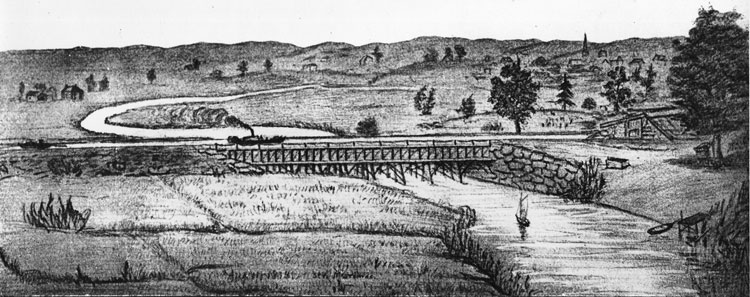
Middlesex Canal Association P.O. Box 333 Billerica, Massachusetts 01821
www.middlesexcanal.org

Middlesex Canal Association P.O. Box 333 Billerica, Massachusetts 01821
www.middlesexcanal.org
| Volume 61 No. 2 | February 2023 |
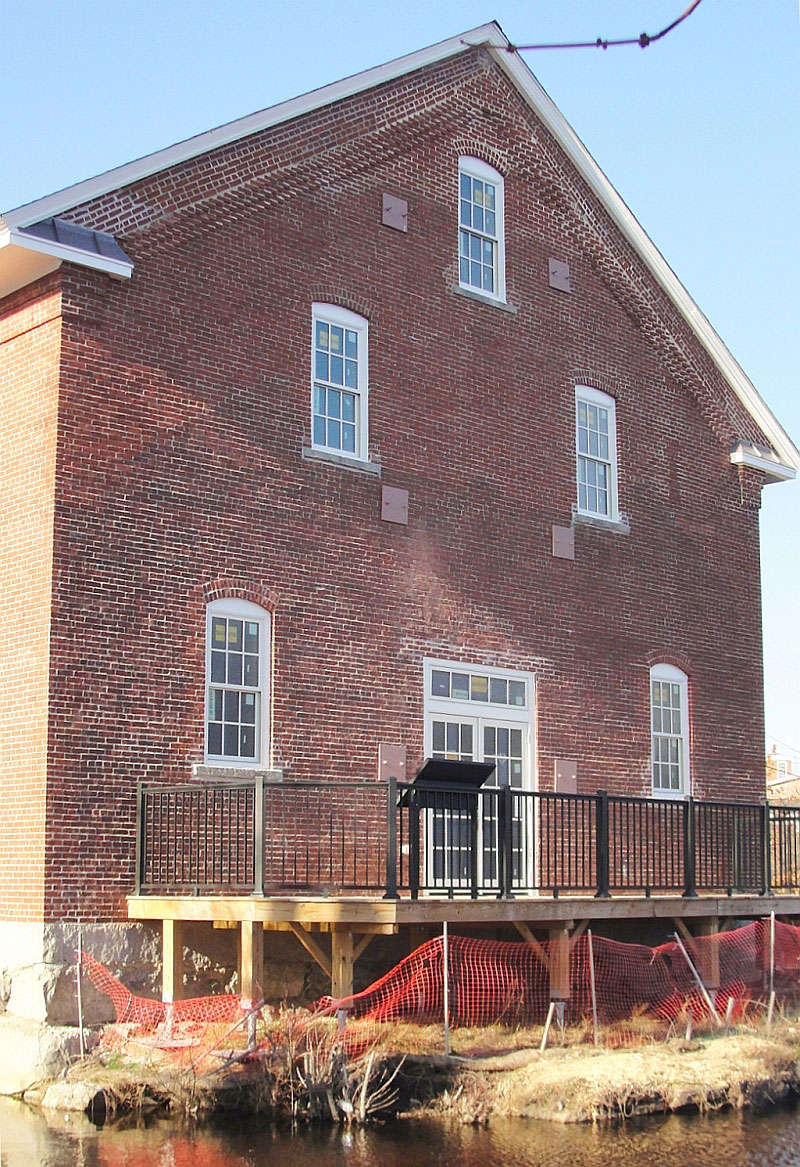
MCA Museum with Windows and New French Door Installed. Moving Forward Toward our goal!
MCA Sponsored Events – 2023 Schedule
Winter Meeting, 1:00pm, Sunday, February 19, 2023
at the Middlesex Canal Association Museum and Visitor’s Center
71 Faulkner Street, North Billerica
“Spinning as an Industry”
Speaker: Zoë Lawson
Hike Beautiful Billerica, 9:45am, Saturday, March 11, 2023
Marlies Henderson, two hour walk south to the smallpox cemetery,
Sign-up required at Billerica Recreation Department, $7.00 wait list,
https://www.facebook.com/groups/HikeBeautifulBillerica
Spring Walk, 1:30pm, Sunday, March 19, 2023
Maple Meadow Aqueduct
Meet at the kiosk, 35 Towpath Drive Wilmington, MA 01887
Bike Tour South, 11:15am, Sunday, April 23, 2023
Meet at the Lowell Train Station. Leaders Dick Bauer and Bill Kuttner
Annual Meeting, 1:00pm, Sunday, April 30, 2023
Speaker and Location: TBA
When available details will be posted on www.middlesexcanal.org
21st Fall Bike Tour, 9:00am, Saturday, September 30, 2023
Meet at the Middlesex Canal Plaque right of the entrance to the
Sullivan Square T Station, 1 Cambridge Street, Charlestown, MA 02129.
Leaders: Dick Bauer and Bill Kuttner
Fall Walk, 1:30pm, Sunday, October 15, 2023
Meet at the southeast corner of the parking lot at the Woburn Cinemas,
25 Middlesex Canal Drive, Woburn, MA 01801
Fall Meeting, 1:00pm, Sunday, October 29, 2023
Speaker and Location: TBA
When available details will be posted on www.middlesexcanal.org
The Visitors Center/ Museum is open Saturday and Sunday, Noon – 4:00pm, except on a holiday (April 9, 2023, Easter).
The Board of Directors meets the 1st Wednesday of each month, 3:30-5:30pm, except July and August.
Check the MCA website for updated information during the COVID-19 pandemic.
TABLE OF CONTENTS
MCA Sponsored Events and Directions to the MCA Museum and Visitors’ Center
President’s Message: “Water Highway” by J. Jeremiah Breen
A Message from the MCA Treasurer Russ Silva
“MCA Fall Bicycle Ride North 2022” by Bill Kuttner
“Middlesex Canal Association Walk: October 2022” by Robert Winters
“A Weather Tight Building” by Betty M. Bigwood
“Water, Water Everywhere, but not a Drop to Drink” by Dick Hawes
“Squire William Blanchard House” Wilmington, MA by Cienna Lyon
Editors’ Letter
Dear Readers,
Welcome to the first issue of Towpath Topics for 2023! Starting off as always is a message from MCA President J. Breen followed by a message from our treasurer, Russ Silva.
Next up are two articles recapping events from last fall. The bicycle adventure is recounted by Bill Kuttner, and Robert Winters regales with the October walk.
The winter MCA meeting on February 19th will feature Zoë Lawson who will give a talk on fiber and spinning. Daughter of long-time MCA founder Fred Lawson, her lecture will be informative, but also a chance to have an in-person event after years of Covid Zoom lectures.
We have reports by Betty Bigwood and a second by MCC: Billerica Section Liaison Dick Hawes. Included is a schematic of the first floor plan and pictures of the weather tight building.
Lastly, Betty Bigwood has submitted a photo of the home of William Blanchard in Wilmington, MA. Included is information by Cienna Lyon from the Reading Municipal Light Department calendar (with permission). William Blanchard was a Hop Inspector. Read it to find out why it relates to the canal!
Enjoy the issue! See you on February 19th.
Sincerely,
Deb, Alec, and Robert
MCA Sponsored Events
Winter Meeting – 1:00pm, Sunday, February 19, 2023: A public meeting of the Middlesex Canal Association is scheduled for Sunday, February 19, 2023 at 1:00 P.M. at the Middlesex Canal Association Museum and Visitor’s Center. Located at 71 Faulkner Street, North Billerica, MA 01862. Zoë Lawson answers the question, Why was Lowell considered a utopia? View the video, Spinning as Industry, recorded at the Charles River Museum, https://youtu.be/3Zisvln1QZ8, and come with your questions for an expert on cloth making before Lowell and the power loom.
A technical writer by day, Zoë Lawson is a spinster and public historian by vocation. She has been spinning for more than 35 years and has given numerous demonstrations at historic sites in the Boston area. An active 18th-century re-enactor, Lawson recently began to explore Medieval textile and fiber production. She enjoys experimenting with historical tools and methods and teaching spinning to anyone who wants to learn by doing. (from Charles River Museum Website)
Note: The Winter Meeting of the Association, a few minutes, will precede the conversation. To check for changes to the program due to snow call (978) 671-2740.
Note: Walks and Bicycle Tours: For more detailed information please access the MCA website at www.middlesexcanal.org about a week prior to the scheduled event.
Directions to Museum: 71 Faulkner Street in North Billerica, MA
By Car
From Rte. 128/95
Take Route 3 (Northwest Expressway) toward Nashua, to Exit 78 (formerly Exit 28) “Treble Cove Road, North Billerica, Carlisle”. At the end of the ramp, turn left onto Treble Cove Road toward North Billerica. At about ¾ mile, bear left at the fork. After another ¼ mile, at the traffic light, cross straight over Route 3A (Boston Road). Go about ¼ mile to a 3-way fork; take the middle road (Talbot Avenue) which will put St. Andrew’s Church on your left. Go ¼ mile to a stop sign and bear right onto Old Elm Street. Go about ¼ mile to the bridge over the Concord River, where Old Elm Street becomes Faulkner Street; the Museum is on your left and you can park across the street on your right, just beyond the bridge. Watch out crossing the street!
From I-495
Take Exit 91 (formerly Exit 37) North Billerica, then south roughly 2 plus miles to the stop sign at Mt. Pleasant Street, turn right, then bear right at the Y, go 700’ and turn left into the parking lot. The Museum is across the street (Faulkner Street). To get to the Visitor Center/Museum enter through the center door of the Faulkner Mill and proceed to the end of the hall.
By Train
The Lowell Commuter line runs between Lowell and Boston’s North Station. From the station side of the tracks at North Billerica, the Museum is a 3-minute walk down Station Street and Faulkner Street on the right side.
President’s Message, “Water Highway”
by J. Breen
John Hancock and his compatriots were in competition with New York, Philadelphia, Baltimore, and Charleston for the shipping trade between the United States and Europe. The significant factor in the competition was the water highway connecting the port to the interior. The Charles River from Boston Harbor to its source is 26 mi. The Hudson is 315 miles, the Delaware, >282 miles, Susquehanna, 444. The Cooper at Charleston was a short, tidal river for which a 22-mile canal to connect it to the Santee River was chartered in 1786. The compatriots chartered the Middlesex Canal Company in 1793 to build a 27-mile canal to the Merrimack River.
The importance of the harbor-water highway combination is manifested in the 1790 census wherein the five locations above are the five largest population centers in the United States. In 1860, with New Orleans replacing Charleston, they were still the largest.
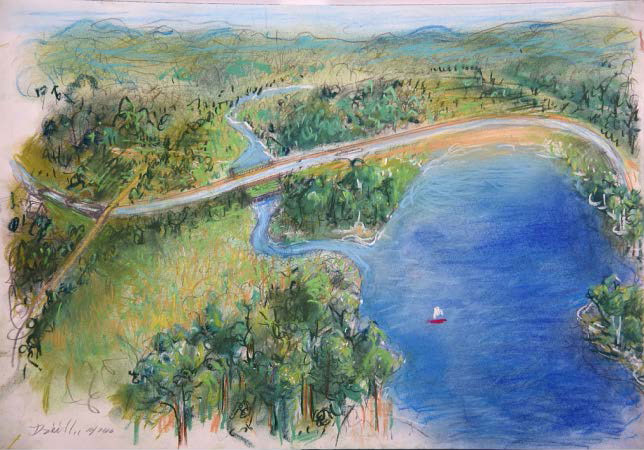
Middlesex Canal Crossing the Symmes River, part of the water highway between Boston Harbor and Concord, NH.
Pastel by Thomas Dahill for the program at the Winchester Historical Society, October 18, 2016.
The artist has captured the sweep of the canal across the land, so very different than the rutted, hilly dirt roads.
The competitor to a ship on water was a horse and wagon on a road. For the cost of a ton shipped from England to Boston, a ton by horse and wagon could be transported 30 miles inland. Three thousand miles, England to Boston, competing against 30 miles on a road, ocean transport is 100 times more efficient as measured in dollars.
A horse and wagon has a capacity of two tons, more or less. A horse and canal boat has a capacity of more than twenty tons, i.e., more than ten times horse and wagon. The wagon on a road could not compete in profitably against a boat on the canal for the 27 miles between the Charles and the Merrimack.
In 1802, a glass factory was built on the bank of the canal in what became Middlesex Village. Sand from New Jersey was brought up the canal to be melted at 2600° by burning wood from the forests of New Hampshire rafted down the Merrrimack and lifted up the three Merrimack locks to the factory. In 1820, 2,000 cords of wood were used to manufacture 320,000 feet of window glass, as reported in Allen’s History of Chelmsford.1
The canal was built because it was 10x more efficient than the one horsepower wagon. But in 1829 the annual report of the Middlesex Canal Company stated that “Rail Roads, the rival of Canals, are as yet in this country, in a state of infancy. In the minds of many the infant . . . will expand to Giant form and swallow Canals and Turnpikes . . . ” Quoted by Mary Stetson Clarke, The Old Middlesex Canal, p. 125. The Boston and Lowell Railroad opened in 1835, and the canal lost 1/3 of its business. The Nashua and Lowell opened in 1837, and the canal lost another third. When the railroad reached Concord NH in 1842, it lost another third, and the canal company liquidated its assets with a final return of capital payment in 1853. The first Boston and Lowell locomotive was rated 30 horsepower. It didn’t haul the equivalent of 30 wagons on a rutted, hilly road, but hauled on smooth rails something like 30 boats, and didn’t freeze in winter. Locomotives were successively more powerful after the B & L’s 30 HP Stephenson: today a locomotive can be rated to as much as 6,000 horsepower.
Notes.
1. Wilkes Allen, History of Chelmsford, p. 75. Haverhill: P. N. Greene, 1820.
A Message from the Treasurer
The Middlesex Canal Association’s thanks go to the thirty-eight individuals who, as of Monday, January 16th, have donated $4,770 to the 2022 Annual Appeal. This includes $2,460 to the Building Fund but only $65 to the Endowment Fund. The rest will be applied to Current Expenses.
The number of donors is about the same as last year. Individual contributions vary from ten dollars to a thousand. The total amount given to the appeal is only 40 to 50% of the amount given in the years between 2012 and 2020. Like last year, some of our largest contributors have donated significant amounts throughout 2022 to the 2 Old Elm Museum Building renovation project directly instead of through the Appeal. Thanks to them too for their generosity.
On the other hand, the amount contributed to the Annual Appeal so far is $700 greater than the total 2021 Appeal when contributions came in as late as April 2022.
If anyone else wishes to send a contribution in any amount for the benefit of the Endowment Fund, the New Museum/Building Fund, or the “General” Fund for Current Expenses, please do, and thank you.
Russ Silva, Treasurer.
MCA Fall 2022 Bicycle Ride North
by Bill Kuttner
Whenever a semi-annual Middlesex Canal bicycle ride approaches, I start getting inquiries by phone or e-mail. “How far is the ride?” “How fast?” “ “How hard?” Of course, all these people are really asking “will I have a good time?” When I’m succinct I might boil my reply to three points: Pump up your tires. Be mentally prepared to expend effort. You’ll do just fine. It is not an athletic feat; I call it an exploration.
And most people do have a good time. This outcome is also due to our use of the Boston to Lowell commuter rail line. It allows a more comprehensive survey of the canal’s alignment and also provides an opportunity for people to shorten their ride if they have somewhere they need to be or they are reaching their riding limit. Our rides and routes had settled into a reliable pattern when several years ago the MBTA began to install advanced railway signal upgrades, replacing weekend rail service with buses. We adapted, sometimes on the day of the ride.
Now commuter rail service on the Lowell Line is back to normal and the ride on October 2 demonstrated the flexibility of our ride concept. Note that the ride had been scheduled for October 1, but Hurricane Ian remnants made Sunday, October 2, the better day, the change being announced on Friday, September 30. At least it was drier, but was still cold and windy.
Given this late rescheduling we were not surprised when a group of only five riders left Sullivan Square shortly after the 9:00am scheduled start time. We were joined by someone in a car who was so keen on learning about the canal that he drove to each first half lecture point to take in the explanatory talk. When we reached Royall House in Medford there were three additional riders waiting to join the ride. They knew that Royall House was on the route and had been given an estimated rendezvous time of 9:45. Now we were eight riders and a motorist in learning mode.
Our practice is to take our lunch break at the park next to the Baldwin mansion just north of Route 128. We had expected one person to join us at Royall House, but it was a complete surprise to be joined by a family of three riders while we were having lunch. They live in Dracut and had intended to take the train from Lowell to Boston and join the ride at the start. After just missing the train they drove with their bikes to the Anderson/Woburn station, parked, and then rode to meet us. Two riders and the motorist had to leave us at this point, but our peloton was now up to nine riders.
Outside Route 128 the roads are conducive to “real riding” and the premier attractions beckoned: the tow rope grooves at the Wilmington town park and the Shawsheen aqueduct at the Wilmington-Billerica line. Then we zig and zag and zig again and cross wet canal segments three times before reaching the museum at the summit pond. Usually, a few riders will leave the ride at the museum and catch a train back to their starting point from the North Billerica commuter rail station a five-minute walk from the museum.
Not this ride. All riders pushed on to Lowell. Association president Jay Breen joined the ride and led the group the rest of the way. There are now ten riders. When we got near the Merrimack River, two of the riders from Dracut split off and headed home. Jay took the rest of us to the Lowell commuter rail station where he saw off the last seven riders loading their bikes on the train.
The third Dracut rider alighted at Anderson/Woburn to retrieve the family car. Four riders alight at Wedgemere (much cheaper than getting off a West Medford). Your chronicler and one other rider went all the way to North Station. The short ride from North Station to Sullivan Square follows a canal and industrial history walking tour offered occasionally by the West End Museum near North Station. The last rider loaded her bike in her car and drove back to Holbrook, getting the award for coming the longest way to join us.
Fall Walk Report - Billerica South
by Robert Winters
What a difference a few years make. The last time we had our “official” walk along the stretch of the canal south from the Billerica museum was 5 years ago. The initial Covid wave canceled the scheduled walk of Spring 2020. Though many things remained as before, there were also a fair number of changes along the trail and its surroundings. I was very grateful to the volunteers who cleared the way in advance of the scheduled October 16, 2022 walk and made other accommodations en route to the smallpox memorial that marks the southernmost part of this walk.
Good weather and the continuing optimism that the pandemic may at last be winding down brought out approximately 35 walkers eager to walk and with plenty of questions and curiosity.
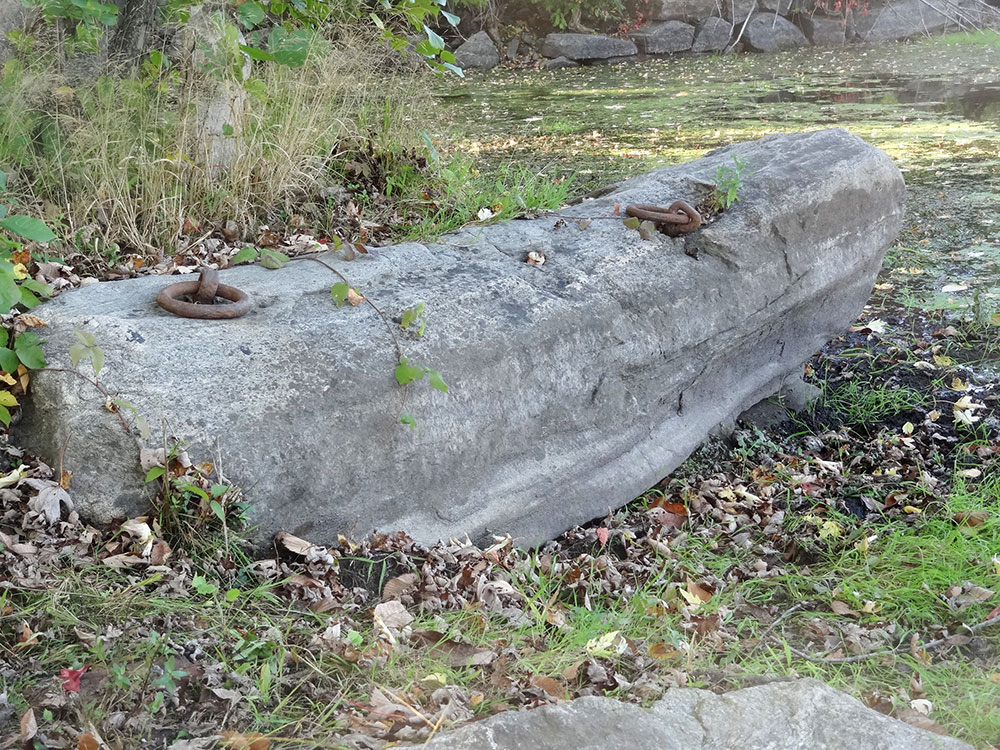
Anchor stone of the floating towpath
Starting from the Museum, we checked out the guard lock and the floating towpath anchor rings adjacent to our new museum building under construction. This location on the Concord River marks not only the canal’s summit level but also the site of the original ground-breaking for the canal construction more than 225 years ago. From there we walked around the summit pond to the “deep cut” section of the canal heading south from Rogers Street and crossing the dormant railroad track en route to the restored historic canal marker at High Street. This location always provides a good opportunity to answer questions and show maps of the area.
Venturing further south across High Street reveals many changes from our walks there many years ago – lots of solar panels and capped hazardous waste sites and a gradual disappearance of much of the railroad yards that once were a major presence in this area. As we headed toward the smallpox memorial as a our usual turnaround spot, there was a new twist to the route. In years past we would have to do some guesswork to locate where a wood plank was usually available to cross the drainage stream created for the diversion of the canal post-abandonment, but this time there was a much better crossing and a new path on the other side of the stream that made for an improved route to the smallpox memorial. I am grateful to whoever created this improved accommodation - and someone was even kind enough to put a temporary “MCA” marker on a concrete bunker to mark the location of the new crossing.
 Makeshift bridge |
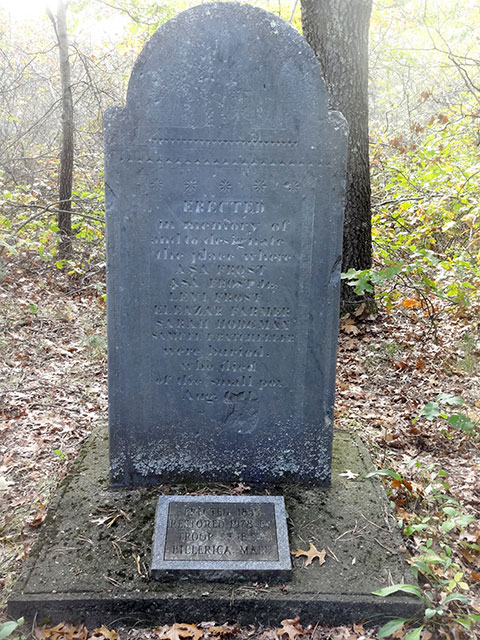 Smallpox marker |
The route back was also an opportunity for some of our walkers to do a little cleanup of the route – a never-ending task in any remote location where the dumping of everything from candy wrappers to lumber to old tires and appliances is commonplace. The best way to preserve “ways” like this is to encourage an active use – be it a pedestrian/bike path or a recreational trail. Both the canal route south from the museum as well as the route of our last Spring Walk north from the museum into Chelmsford could use a little more love and attention.
A Weathertight Building
by Betty M. Bigwood
Hallelujah! We finally got a weather tight building in December 2022. This would not have been possible except for the financial support of the Billerica Community Preservation Fund ($280,000), a Grant from the State from Rep. Lombardo’s office ($50,000) and support from the membership. A little over $600,000 was spent in 2022.
We had to have a dry building before the Billerica Electrical Inspector would apply to the National Grid to hook us up to electricity. Russ sent a check to the National Grid on 4-15-2019 for $6070.28. We were delighted to pay this as we initially were given estimates of costs in the $50,000 range because of materials, distance, poles and changes anticipated. We never dreamed it would take so long. The recent application to the National Grid, an English Company, was requested on 12-13-2022. We now expect to have electricity in the building by the end of February or early March 2023.
Work at 2 Old Elm ceased in mid-December 2022. We had hoped to have the concrete floor poured but the delay in materials (windows, doors, granite sill for the new deck door, pushed us into really cold weather. Contractor Bill Cogley was able to level the floor and ready the site for the concrete in April. And while he offered to “warm” the building now so concrete could be poured and cured the added expense was not justified.
Kudos to Dick Hawes who undertook getting water connected to 2 Old Elm. Dick explains his efforts in an article in this issue of TT. Nothing is easy or routine in this project. His reference to Coleridge’s “Ancient Mariner” raised sympathy to his dedication.
The Billerica Building inspector’s request for the full installation of the Fire Alarm System – already paid for and ready for National Grid hookup – awaits final connection. This will allow us to start moving boxes etc. across the street.
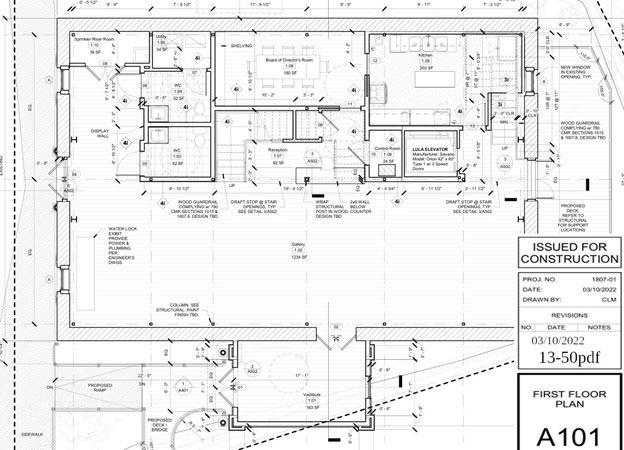
First Floor Plan for MCA Museum, 2 Old Elm Street, North Billerica, MA
I have included Caveney’s architectural drawing of the first floor. The Commonwealth has numerous regulations which need to be fulfilled: double stairs, commercial kitchen, doors which open outward, double toilets – all of which take up space. We have done our best.
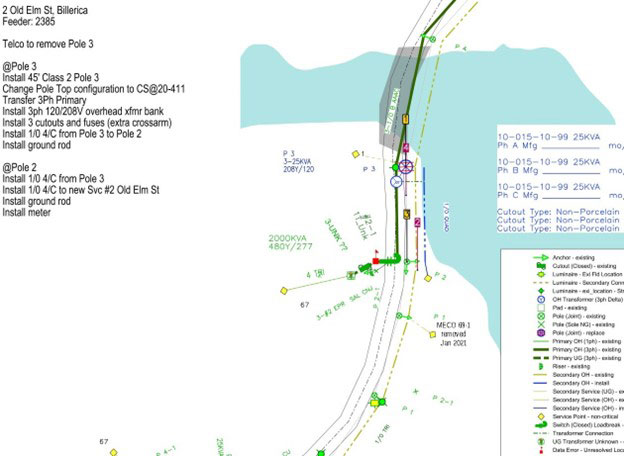
Detail for National Grid Pole Locations at 2 Old Elm Street
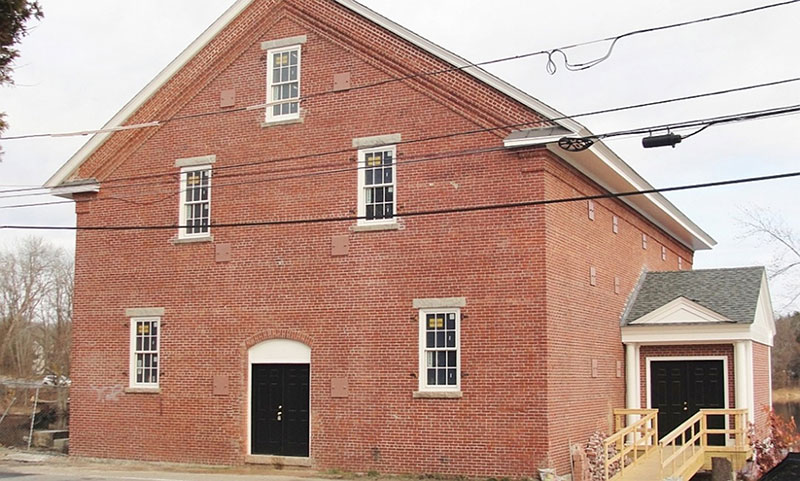
Wires spanning the front of 2 Old Elm Street
I just received a call from Contractor Bill Cogley. He is making up his 2023 agenda and wants to know what we hope to accomplish. First a concrete floor, a 300 ft sewer line for connection to the Town, an ADA accessible platform lift and a heating/ air conditioning system. We will be raising money nonstop!
“Water, Water everywhere But Not a Drop to Drink”
by Dick Hawes, Building Committee
With apologies to Samuel Coleridge, sometimes it felt like we were stuck in the Sargasso Sea with no wind in our sails trying to get the water and sewerage into 2 Old Elm.
The first effort was getting approval of the drawings from the Billerica Engineering Department. Landplex (civil engineers) had created a set of drawings that specified the design intent for our requirements. Billerica Engineering then returned with their specifications and changes to the drawings. It was about this time, April 2022, that I became fully immersed in the project. My first task was acting as an intermediary between the two organizations and trying to move the project forward. The back and forth went on until July or August when miraculously we had a set of signed drawings.
I will mention at this point that the Town of Billerica has a new DPW head and it is generally known his requirements are what people around town call “gold plated”. Our project is no exception. The approved drawings specified an expensive mechanical valve with shutoffs at both ends as a replacement for a portion of the 10” water main rather than tapping the water main. Excavators and engineers have told me this is normal for a housing development or condo complex, not a single building.
The next step was to find an excavation contractor to execute the plan. I approached Mark Farmer, part of John Farmer & Sons, to handle the job. Mark agreed to do the work on a time and material cost. The building committee agreed and it was time to move forward.
After some conversation and planning with Mark, I went to the Water Dept. and paid $600 for the water main tapping permits. I also called our neighbors, Pace Industries, and let them know sometime in the coming weeks the water would be shut off for a day to cut the main and insert the infrastructure for our water supply. Mark had purchased the valves, shut-offs and other material required for the installation. At this time Mark went to Pace to let them know which day he planned to commence the excavation. Pace told him this was unacceptable, and they needed a weeks’ notice and it could only be done on a Friday. This new requirement stopped the work from continuing. The next Friday turned out to be rain, so we shot for the following week. The forecast for that Friday was rain in the morning followed by clearing in the afternoon. Mark showed up early and got to work in the pouring rain. I got to the job site by 9:30 to see what was transpiring. It turned out to be a lot! Mark could not locate the main and was hitting a concrete casing which no one knew was in that area. The only maps at the Water Dept. were from 1898 and were not accurate. Mark made a call to the town; they came, took a look, and said they would be back on Monday with detection equipment to try and give us a better approximation of where to dig. The town and Mark (Mark is a former town engineer) decided on the spot that seemed promising but we had to wait for the following Friday.
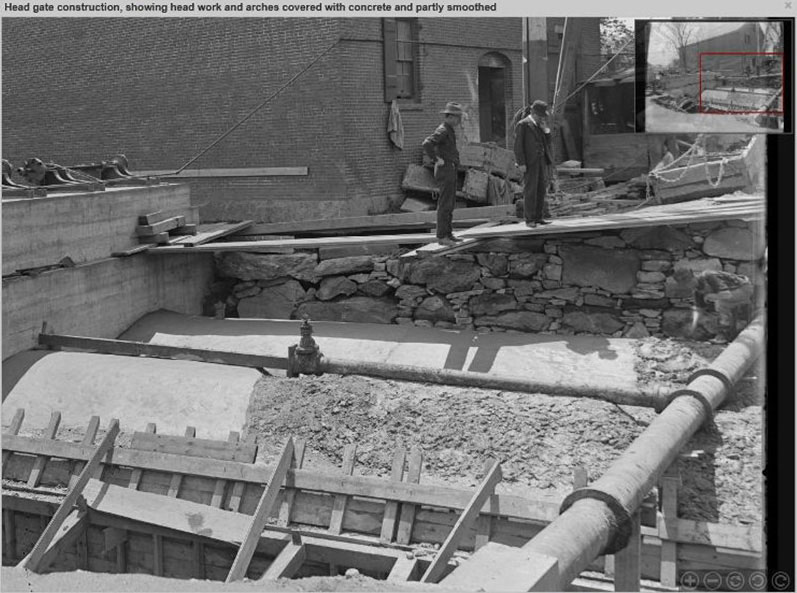
In the meantime, J. Breen had found four and I had found one actual photograph of the original under road construction circa 1900 in the town historic archives. Looking at the photos confirmed the next dig should be successful. It was, to a point. Mark found the 10” water main, but he also found it was leaking. The work stopped and the Water Dept. was brought in to repair the leak. This turned out to be a break for us because the manager (now on his third call to this job) acquiesced and let Mark tap the 10” main and not cut and replace the main. Mark was able to return the valves for a $5,000 saving for the project. A contractor who specializes in tapping water mains was brought in and had the main tapped with a 4” pipe in short order without shutting off the water. When this was complete, Mark tapped the 2” water line. He was now ready to dig for the sewerage at the front of the building. The sewer line just ran out to the edge of the street where it was capped. We now had water and sewer lines running out of the building. The water is now fully connected, and the sewer will wait until spring for the final run up the street and connection to existing lines.
One other item of note is that at the corner of the building sat an abandoned storm drain in a location that would block the water lines from entering the building. We were hoping that since it was totally clogged, we could eliminate it. But no, the town (very fussy with environmental issues) wanted it restored. Another drain is supposed to run into it while this runs into another near the bridge, a chain of drains. With there being not enough room for both the drain and water to exist side-by-side Mark had to make a custom drain basin, short enough to allow the water to run under it. The town accepted this.
While all this transpired; Bill Cogley’s crew had to open holes in the foundation of 2 Old Elm to accept the new water and sewer lines. This also was no small task. The foundation and its surroundings are made up of rocks and very large boulders. I should give credit here to Bill and Mark for a very smooth and productive working relationship. That end of the job could not have gone any better despite dealing with a 150-year-old building of suspect construction.
As of now, we are in a respite for the winter and hope to finish the sewerage in April. I am hoping the “albatross” has fallen from our necks and the remaining work will go smoothly. However, no one knows what lies beneath 2 Old Elm Street and the 1930 canal bridge. We will find out.
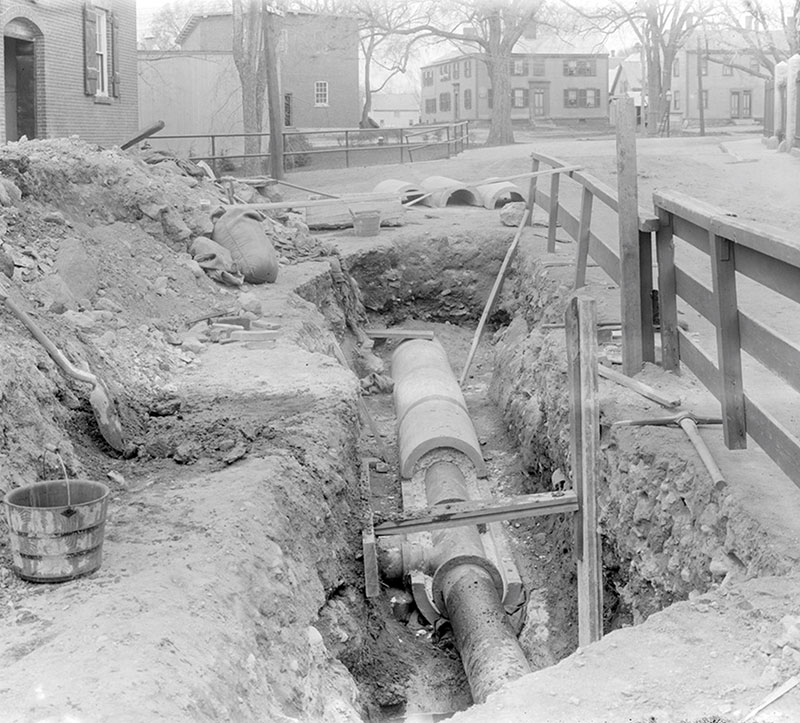
Water main project showing the corner of 2 Old Elm Street. the warehouse at the end of the museum parking lot,
the Joel Dix (Canal Boat Captain) House and a piece of the Middlesex Hall which was an extension of the Mears Tavern
Squire Blanchard House
200 Middlesex Avenue, Wilmington
circa early 1900s
This house on the corner of Middlesex Avenue and Glen Road in Wilmington was the home of Squire William Blanchard, Jr. who served as the Hop Inspector for the Commonwealth of Massachusetts in the early 1800s. The two-story Federal style house is believed to have been built around 1800, with a central entry surrounded by Doric pilasters, a transom light, and a central attic gable with a blind fan detail. The house is now part of the Centre Village Historic District.
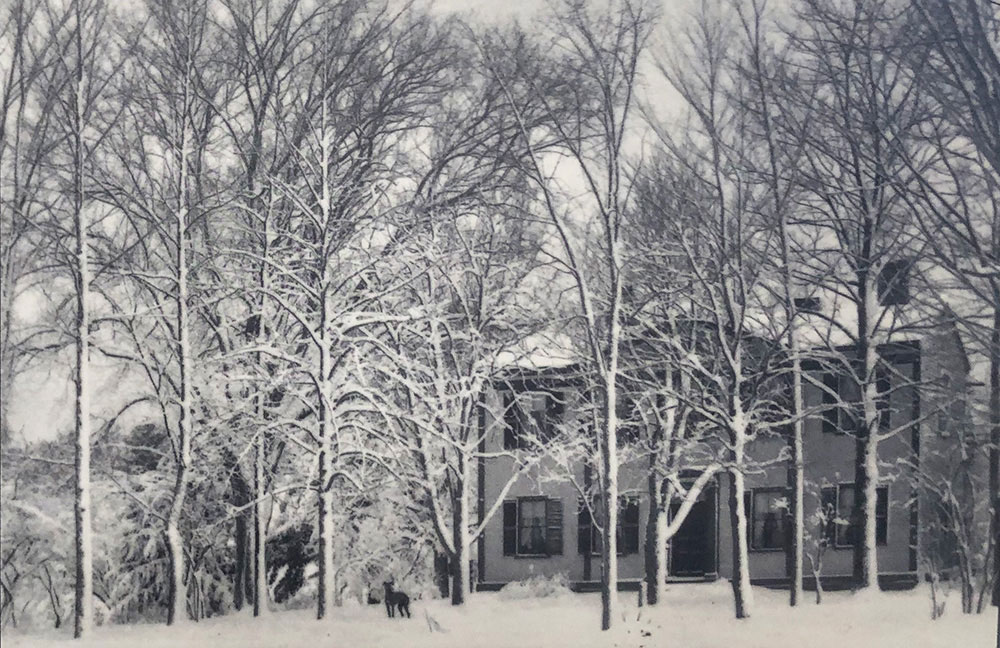
This picture appeared on the Reading Municipal Light Department calendar.
Provided by permission of Cienna Lyon, author
Known as the Hop Squire, William Blanchard, Jr. was the son of Col. William Blanchard, who fought in the battle in Lexington and commanded the 4th Regiment of the Massachusetts Militia. As Hop Inspector, William, Jr. was paid an annual salary of $2,000 and, according to historical records, the only other employee paid such a high salary in the Commonwealth at the time was the Governor. While not inspecting hops, he worked in his home as an attorney.
Wilmington’s high elevation was conducive to growing hops and at the growing peak between 1806 and 1837, the town shipped out over 76,000 bags (16 million pounds) of hops via the Middlesex Canal to Albany, New York. The annual revenue for the hop shipments in 1812 is believed to be $2 million which is estimated to be more than $40 million today.
Blanchard was responsible for ensuring that only high-quality hops were shipped out. Meticulous records were kept of the number and quality of the bags shipped, which indicates the importance of the role of Hop Inspector. As a result of a drop in prices and a blight that killed many plants, hop production in Wilmington declined in 1837.
MISCELLANY
Back Issues - More than 50 years of back issues of Towpath Topics, together with an index to the content of all issues, are also available from our website http://middlesexcanal.org/towpath. These are an excellent resource for anyone who wishes to learn more about the canal and should be particularly useful for historic researchers.
Estate Planning - To those of you who are making your final arrangements, please remember the Middlesex Canal Association. Your help is vital to our future. Thank you for considering us.
Membership and Dues – There are two categories of membership: Proprietor (voting) and Member (non-voting). Annual dues for “Proprietor” are $25 and for “Member” just $15. Additional contributions are always welcome and gratefully accepted. If interested in becoming a “Proprietor” or a “Member” of the MCA, please mail membership checks to Neil Devins, 28 Burlington Avenue, Wilmington, MA 01887.
Museum & Reardon Room Rental - The facility is available at very reasonable rates for private affairs, and for non-profit organizations to hold meetings. The conference room holds up to 60 people and includes access to a kitchen and restrooms. For details and additional information please contact the museum at 978-670-2740.
Museum Shop - Looking for that perfect gift for a Middlesex Canal aficionado? Don’t forget to check out the inventory of canal related books, maps, and other items of general interest available at the museum shop. The store is open weekends from noon to 4:00pm except during holidays.
Web Site – The URL for the Middlesex Canal Association’s web site is www.middlesexcanal.org. Our webmaster, Robert Winters, keeps the site up to date. Events, articles and other information will sometimes appear there before it can get to you through Towpath Topics. Please check the site from time to time for new entries.
The Canal the Bisected Boston: https://www.youtube.com/watch?v=u3yvlBAPGmg
The Middlesex Canal (1793-1860), dug by hand from the Merrimack River at Middlesex Village in Chelmsford to the Charles River at Charlestown during the second term of George Washington’s presidency, played a major role in the development of Boston. Boats were drawn by horse to the Charles River. There they were pulled by chain across the Charles River and down Mill Creek, which bisected the city, to the long wharfs of Boston Harbor. Written and narrated by David Dettinger, author of the definitive study of the Canal extension in Boston from 1810-1830. – Videotaped and edited by Roger Hagopian
The first issue of the Middlesex Canal Association newsletter was published in October, 1963.
Originally named “Canal News”, the first issue featured a contest to name the newsletter. A year later, the newsletter was renamed “Towpath Topics.”
Towpath Topics is edited and published by Debra Fox, Alec Ingraham, and Robert Winters.
Corrections, contributions and ideas for future issues are always welcome.
